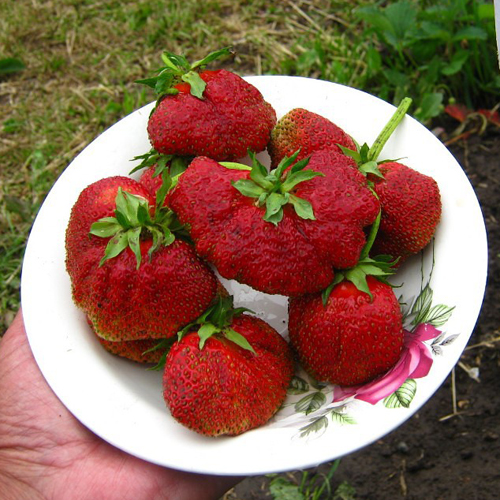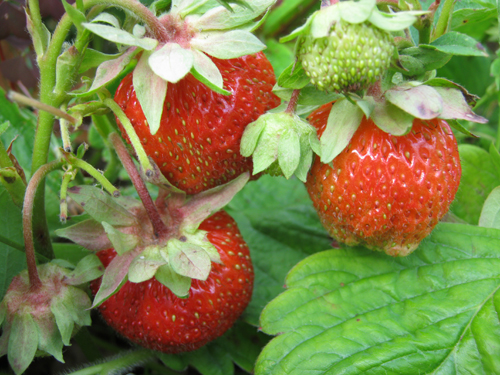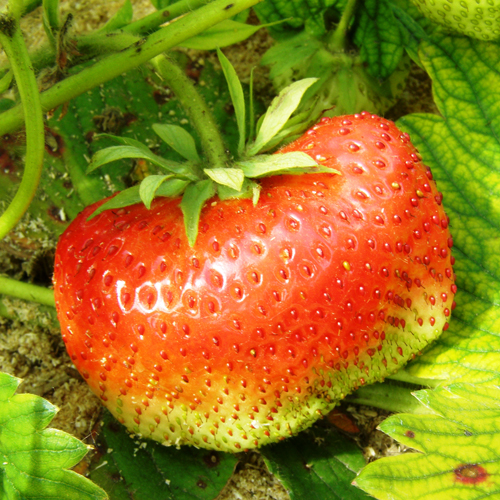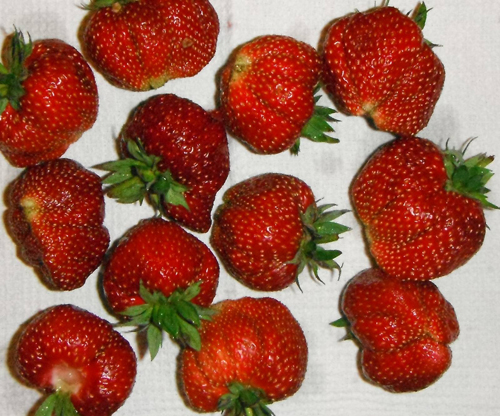Strawberry variety Mashenka (Moscow Jubilee)
Mashenka is a non-repairable variety of garden strawberries (strawberries) of early ripening. Bred by the labors of Russian breeders under the leadership of N.K.Smolyaninova back in 1953, at a fruit and vegetable station in the Moscow region. To obtain were used hybrid seedlings Komsomolskaya Pravda and Krasavitsa Zagorya. The variety has a second name, less known - Moscow Jubilee. Despite its age, it is still very popular with gardeners, and for good reason. Mashenka is famous for her productivity, large-fruited, excellent taste of berries, unpretentious care and undemanding to soil and climate, as well as good resistance to a variety of diseases. And this impressive list of advantages allows our heroine to confidently compete even with “giant” varieties, favorites of the strawberry market. She has only one nuance, in which she loses to the strawberry "barons" - she is not suitable for commercial cultivation and lives only in the garden plots of amateurs.

The plant is powerful, medium spreading, rather compact, up to 45 cm high. The leaves are large, bright green in color. Petioles are strong, stretching upwards. Abundant formation of whiskers in the first 2-3 years of cultivation, then the number of whiskers sharply decreases. Mashenka's first-order flowers are very unusual - they grow together in several pieces, as a result of which huge comb-shaped berries are tied. This phenomenon is called fasciation. Someone calls this feature the dignity of the variety, someone else considers it an ugliness, and if we speak in encyclopedic language, such a berry is substandard. However, this phenomenon is single, in the bulk of the flowers are formed and develop without deviations and the most common fruits are tied. Strawberry flower stalks are thick, tall, powerful, formed in large quantities, and are laid on the ground under the weight of the harvest.

Mashenka's berries are large, have a comb-like or fan-shaped, slightly flattened shape during the first collection, during subsequent collection it changes to the correct blunt-conical. The skin is dark red, almost burgundy when fully ripe, shiny. Achenes are yellow, depressed to medium depth. The pulp is not dense, very juicy, fleshy, with a strongly pronounced strawberry aroma. Mashenka's taste is really up to the mark. The taste harmoniously combines sweetness and sourness, very rich. According to gardeners, it is worth trying the berries of this variety once, and you can no longer refuse to grow it! In comparison with modern solid-fruited varieties, our heroine has berries that can be safely called "the very strawberries" that many ate in childhood with their grandmother. There are no cavities in the pulp, due to which the fruits have an impressive mass along with large sizes. Berries ripen, starting from the base; in immature, the tip is colored light green.

The fruit is especially great fresh, but is also ideal for processing. Unless they are not particularly suitable for storage in frozen form - they are too soft and juicy, when defrosting they will turn into a homogeneous mass. The transportability of the berries is rather low, and their presentation is not always pleasing - they are too heterogeneous. Thus, Mashenka will not become in demand on the market, but everyone will be happy at home, and even the neighbors will be envious.
The average weight of berries in the season is 40-60 grams, at the first harvest they are simply huge - up to 120 grams, and sometimes even more.The fruits do not become smaller by the end of fruiting, even the very last ones can weigh about 70-90 grams. The fruiting period itself is quite compressed, strawberries give up the entire crop very quickly. Thus, it is not difficult to calculate the yield of one plant, but this indicator can vary greatly - from 500 grams to 1.5 kg or more.

It should still be said that indicators of more than 1 kg are a rather random phenomenon, independent of the amount of feeding and care, which is typical for modern varieties of an intensive type. In addition, strawberries are not repaired, which imposes some restrictions on their possible productivity. And even when grown indoors, one cannot be 100% sure that the yield will exceed the 1 kg mark. But by the way, some gardeners practice this technique - at the end of fruiting, they mow the tops, do not water the plants for about a month, and then provide them with an abundant amount of moisture. Thanks to such an event, you can make Masha bear fruit a second time. But how badly it will affect the health of plants and their future productivity is a rather interesting question.
Strawberries are resistant to various diseases of the root system, fungal diseases. Giant berries can be affected by gray rot during long ripening, but the problem is solved by mulching. The variety is frost-hardy and winter-hardy, calmly tolerates drought, generally speaking, our Masha is very "tenacious". And these are not just words - some gardeners have descendants of old Soviet times on their plots. Plants, whose distant ancestors lived in the garden back in the 60s, with minimal care and timely rejuvenation, still delight their owners, one might say, "from generation to generation." However, it is worth noting that you still need to take care of the plantation - strawberries will respond to all your efforts with a good stable harvest.
There are no peculiarities in the agrotechnics of Mashenka's cultivation. She does not require much attention to herself, only the most basic care techniques are needed. Of the nuances, we can only note this: planting is best done in the summer, in mid-July - early August, in order to get a good harvest next year. Another point - if you want to grow giant berries weighing 100-120 grams, you need to remove some of the buds. Planting strawberries should be updated for 4-5 years of cultivation.
Let's make a small conclusion. This time-tested variety can be confidently called one of the most reliable. It is good from all sides, and most importantly, it is stable and invulnerable, very unpretentious and will delight you with a stable harvest even in the harsh climatic conditions of the northern regions. But, of course, Mashenka also has disadvantages. Firstly, it is unsuitable for growing on an industrial scale due to the not very attractive presentation of the berries and their not very good transportability. Secondly, the low yield in comparison with other popular varieties, which also makes our heroine not very attractive for commercial use. Thirdly, limited productivity, which cannot be increased significantly, no matter how much you feed the strawberries and no matter how you conjure them. Another nuance, especially relevant at the present time, is that it is difficult to find the very real Mashenka and not fall for the deception of unscrupulous sellers. On the other hand, the variety is widespread and still very popular, so planting material can often be obtained from amateur gardeners.








